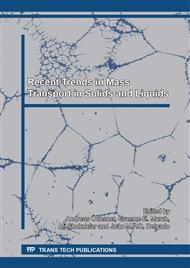p.135
p.141
p.151
p.161
p.167
p.173
p.181
p.186
p.191
Annealing Effects in Conventionally Cast and Homogenized Al-Zn-Mg(-Sc-Zr) Alloy
Abstract:
Al-based alloys are very preferred for automotive manufacture to produce lightweight vehicles. The positive effect of Sc,Zr-addition on the mechanical properties in Al-based alloys is generally known. Microstructure, mechanical, electrical and thermal properties of the conventionally cast and homogenized Al–Zn–Mg alloy with and without Sc,Zr-addition during isochronal annealing were studied. The electrical resistometry and microhardness together with differential scanning calorimetry measurements were compared to microstructure development that was observed by optical microscopy and transmission and scanning electron microscopy. It was observed that the Sc,Zr-content in the alloy after casting is not homogeneously distributed but concentrated in randomly localized matrix regions and together with Zn and Mg in the particles at grain boundaries. However, the hardening effect after annealing above 280 °C lightly reflects the Sc,Zr-addition. The distinct changes in resistivity and microhardness as well as in heat flow of the alloys studied are mainly caused by formation/dissolution of the Guinier-Preston zones and subsequent precipitation of the metastable particles from the Al–Zn–Mg system. The eutectic Zn,Mg-containing phase partly disappeared during the annealing above ~ 390 °C. Melting of the Zn,Mg-containing phase was observed at ~ 475 °C. The decomposition sequence of the supersaturated solid solution of the studied alloys is compatible with the decomposition sequence of the Al–Zn–Mg system minimally up to ~ 380 °C.
Info:
Periodical:
Pages:
167-172
Citation:
Online since:
November 2017
Authors:
Keywords:
Price:
Сopyright:
© 2017 Trans Tech Publications Ltd. All Rights Reserved
Share:
Citation:


